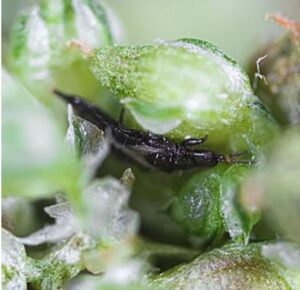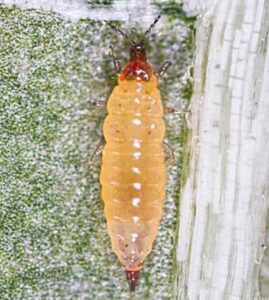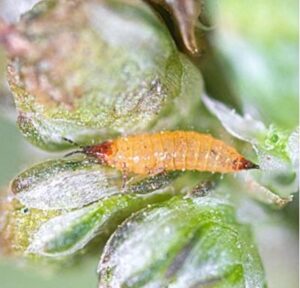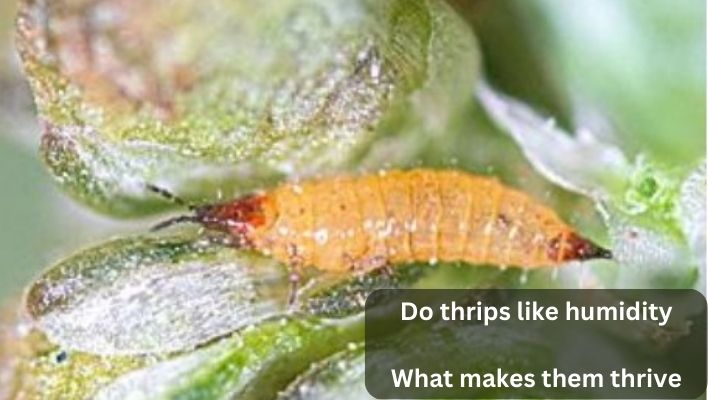Thrips, tiny but mighty pests, can wreak havoc on your plants. One of the key factors that attract thrips to your garden is humidity. But why do thrips thrive in humid environments?
Thrips are tiny insects that can cause significant damage to plants, especially those grown for commercial use. Humidity is one of the most important factors affecting thrips’ growth and reproduction.
In this blog post, we’ll take a closer look at thrips and humidity, including what types of humidity they prefer, how they are affected by changes in humidity, and what you can do to control thrips in your garden or greenhouse.
We will look at the ideal humidity levels for thrips, the effects of high and low humidity on thrips populations, and strategies for controlling thrips in humid environments.
Whether you’re a commercial grower or a hobby gardener, this post will provide valuable insights into keeping thrips at bay and protecting your plants from damage. So, let’s dive in and learn more about these pesky insects and how to deal with them.
What humidity level do thrips like
Thrips prefer warm and humid environments. Like aphids, High humidity levels provide the ideal conditions for thrips to thrive, allowing them to reproduce and spread quickly. They are commonly found in greenhouses, nurseries, and other indoor environments with high humidity levels.
Thrips are tiny insects that can cause damage to plants by feeding on their leaves and flowers. They are common pests in gardens and greenhouses and can be difficult to control.
One important factor that affects thrips populations is humidity. Understanding the humidity level that thrips prefer can help gardeners and growers take steps to keep these pests at bay.
Thrips prefer a moderate to high humidity level. They thrive in environments where the relative humidity is between 60-80%. In these conditions, thrips can reproduce quickly, and their populations can grow rapidly. High humidity also provides a protective environment for thrips, making it more difficult for predators and natural enemies to control them.
In contrast, low humidity levels can inhibit thrips populations. When the relative humidity is below 60%, thrips may have difficulty reproducing and may not survive as well. This can help to keep thrips populations under control.
However, it’s important to note that humidity levels alone are not the only factor that affects thrips populations. Other factors, such as temperature, food availability, and the presence of natural enemies, also play a role. Gardeners and growers should take a holistic approach to manage thrips, incorporating cultural and chemical control methods.

The role of humidity in thrips’ biology
Humidity plays a crucial role in the biology of thrips as it affects their survival, reproduction, and feeding. High humidity levels are beneficial for thrips as it helps them maintain their water balance and survive in dry environments. On the other hand, low humidity levels can lead to desiccation and death of thrips.
Thrips are known to have high water requirements and are dependent on relative humidity levels to survive. They can maintain their water balance by absorbing water vapor through their cuticle, which helps them survive in dry conditions.
High humidity levels also help keep the environment moist, essential for developing and surviving thrips’ eggs and larvae.
Humidity also plays a role in the reproduction of thrips. Female thrips require high humidity levels to lay eggs, as dry conditions can lead to reduced fertility and egg production. Additionally, high humidity levels also promote the growth and development of thrips’ larvae, which is essential for their survival.
Humidity levels also affect the feeding behavior of thrips. High humidity levels can increase the activity of thrips, leading to increased feeding and reproduction. On the other hand, low humidity levels can lead to reduced feeding activity and slow down the growth and development of thrips.
In summary, humidity plays a crucial role in the biology of thrips as it affects their survival, reproduction, and feeding. High humidity levels benefit thrips, while low humidity can lead to desiccation and death. Therefore, maintaining optimal humidity levels is essential for managing and controlling thrips populations.
Where do thrips come from
Thrips are tiny insects that can come from a variety of sources. Some of the most common ways that thrips can enter a garden or greenhouse include:
- Outdoor Sources: Thrips can come from outdoor sources such as weeds, wildflowers, and other plants. They can also be carried in on wind currents or the bodies of animals such as birds or bees.
- Nursery Stock: Thrips can also come from nursery stock, as they can be present on plants purchased or brought into a garden or greenhouse.
- Greenhouse Sources: Thrips can also originate from within a greenhouse, as they can reproduce and spread quickly in the warm and humid conditions found in many greenhouses.
- Importation: Some thrips are imported with plants, flowers, or fruits that are brought in from other countries; this could be a major cause of thrips in some locations.
- Other sources: thrips can also come from other sources such as the soil, the water, or other insects that carry thrips eggs.
It is important to monitor the presence of thrips and take steps to prevent and control infestations to keep them from spreading. This can include implementing preventive measures such as using sticky traps, using natural predators, and practicing good sanitation in the garden or greenhouse.

Effect of high Humidity on plants
High humidity can have several negative effects on plants. Some of the most common include:
- Disease: High humidity can create an ideal environment for the growth and spread of fungal and bacterial diseases. These pathogens thrive in moist conditions and can cause leaf spots, wilting, and even death in severe cases.
- Pest Infestations: High humidity can also attract pests such as thrips, spider mites, and whiteflies, which can damage plants and reduce crop yields.
- Slow Growth: High humidity can slow down the growth and development of plants, as they are less able to absorb water and nutrients through their roots. This can lead to stunted growth and reduced yields.
- Poor Air Circulation: High humidity can also lead to poor air circulation, which can cause leaves to turn yellow and drop prematurely. This can reduce the overall health and appearance of the plant.
- Dormancy: High humidity can cause plants to go into dormancy, meaning they stop growing; this could be due to the plant not being able to absorb the water and nutrients it needs to survive.
Overall, it’s important to monitor humidity levels in greenhouses and indoor growing environments and to reduce humidity if necessary to ensure healthy and productive growth.
How to get rid of thrips
Thrips can be a major problem for gardeners and farmers, as they can reduce crop yields and damage the appearance of plants. If you’re struggling with a thrips infestation, there are several ways to get rid of them. Here are some tips for getting rid of thrips:
Maintain proper humidity levels:
Thrips thrive in humid conditions, so maintaining proper humidity levels is one of the most effective ways to get rid of thrips. By reducing humidity, the environment becomes less hospitable for thrips, making it difficult for them to survive and reproduce.
Here are a few steps that can be taken to reduce humidity and get rid of thrips:
- Proper Ventilation: Ensure that your greenhouse or indoor growing environment has proper ventilation to exchange fresh air. This can help to reduce humidity and prevent the buildup of moisture.
- Dehumidifiers: Using dehumidifiers to remove excess moisture from the air can help to reduce humidity levels and make the environment less favorable for thrips.
- Proper Drainage: Ensure that your plants are planted in well-drained soil and that excess water is removed promptly to prevent standing water.
- Monitor Humidity: Regularly monitor humidity levels using a hygrometer, and take steps to reduce humidity if necessary.
- Pest Control: Use insecticides or biological control methods such as beneficial insects to eliminate thrips and other pests.
It’s important to keep in mind that thrips have different life stages and might need different methods to get rid of them. It’s also essential to monitor the environment to prevent future infestations.
Use sticky traps:
Using sticky traps is a popular method for controlling thrips populations. Sticky traps are strips of paper or plastic coated with a sticky substance that attracts and traps thrips. Here are some steps to use sticky traps to control thrips:
- Purchase sticky traps from a garden supply store or online.
- Place the sticky traps where thrips are commonly found, such as near the base of plants or windows and doors.
- Monitor the sticky traps regularly and replace them when they become covered in thrips.
- Keep an eye on the thrips population; if the traps are not trapping enough thrips, you can consider using more traps.
- Use sticky traps in combination with other control methods, such as insecticides or natural predators, to achieve the best results.
It’s important to note that sticky traps are not a permanent solution to controlling thrips populations. They are a tool to monitor and reduce the population, but other methods should be used in conjunction with them.
Use insecticidal soap:
Insecticidal soap is a popular method for controlling thrips on plants. The soap suffocates the pests and disrupts their cell membranes, ultimately leading to their death. Here are a few tips for using insecticidal soap to get rid of thrips:
- Get ready to use insecticidal soap from a garden store online.
- Spray the soap solution directly onto the affected plants, covering the leaves’ upper and lower surfaces. Be sure to spray the solution on the new growth and on the soil, as thrips could be hiding there.
- Repeat the application every 3-7 days, or as needed, until the thrips are under control.
- Be sure to spray the plants in the early morning or late evening when the thrips are less active.
- Avoid using insecticidal soap on hot or sunny days, as this can cause damage to the plants.
- Monitor the plants regularly for any signs of thrips and repeat the treatment if necessary.
It’s important to note that insecticidal soap is not a long-term solution for thrips control; it’s just a temporary measure to control the population. A combination of physical, biological, and cultural control methods should be used to manage thrips sustainably.

Use neem oil:
Neem oil is a natural and effective way to control thrips on plants. It is derived from the seeds of the neem tree and contains compounds that are toxic to thrips and other pests. Here are a few tips on how to use neem oil to get rid of thrips:
- Mix neem oil with water: Neem oil is typically sold as a concentrate and must be diluted with water before use. Mix 2-3 tablespoons of neem oil with one quartz of water and shake well.
- Apply the solution: Use a spray bottle or a pump sprayer to apply the neem oil solution to the leaves, stems, and other plants infested with thrips. Make sure to cover the entire plant, including the undersides of the leaves.
- Repeat the treatment: Repeat the treatment every 7-10 days to ensure that all thrips are killed. Neem oil breaks down quickly in sunlight and must be reapplied for continued protection.
- Be careful when using Neem oil as it can harm beneficial insects such as ladybugs and bees; it is best to apply it in the evening when they are not active.
- Always read the product label and safety instructions before using neem oil to ensure proper use and avoid any harm to yourself or the environment.
By following these steps, neem oil can effectively control thrips and protect your plants.
Introduce beneficial insects:
Introducing beneficial insects is one of the most effective ways to control thrips populations naturally and sustainably. Some beneficial insects that can be used to control thrips include:
- Lacewings: Lacewing larvae are voracious predators that feed on thrips, aphids, and other soft-bodied insects. Adult lacewings also feed on nectar and pollen, so they can help to pollinate your plants.
- Ladybugs: Ladybugs are also known to feed on thrips and other pests. They are most effective when used with lacewings, as they can help control any remaining thrips after the lacewings have done their work.
- Parasitic Wasps: There are several species of parasitic wasps that can be used to control thrips. These wasps lay their eggs inside the thrips, which hatch and consume the thrips from the inside out.
- Predatory Mites: Predatory mites such as Phytoseiulus persimilis and Amblyseius swirskii are known to feed on thrips. They will reduce thrips populations in greenhouses and indoor growing environments.
It’s important to note that introducing beneficial insects is not a quick fix; it takes time for the population of beneficial insects to grow and to control the thrips effectively.
Also, it’s important to maintain a good balance between beneficial insects and other factors, such as humidity, temperature, and light, to create an ideal environment for the beneficial insects to thrive.
Keep the garden clean:
Keeping the garden clean is another effective method to get rid of thrips. This includes:
- Removing Dead Leaves and Debris: Thrips often lay their eggs on dead leaves and debris, so removing these from the garden can help reduce the population.
- Pruning: Regularly pruning damaged or infected plant parts can help prevent the spread of thrips and other pests.
- Mulching: Using a thick layer of mulch can help prevent thrips from laying their eggs in the soil, and it also can help to retain moisture in the soil.
- Watering: Watering the plants in the morning or early evening can help to reduce humidity levels in the garden, making it less favorable for thrips to thrive.
- Companion planting: Some plants, such as marigolds, dill, and fennel, are known to repel thrips and other pests. Planting these in and around your garden can help to keep thrips at bay.
- Maintaining a balance of beneficial insects: Encourage a balance of beneficial insects such as ladybugs, lacewings, and parasitic wasps in your garden, as they will help to control thrips populations.
- Creating barriers: Putting up barriers such as sticky traps or row covers can help to keep thrips out of the garden.
Remember, it’s important to take a multi-pronged approach to get rid of thrips, as each method will only be effective on its own.
Use a pesticide:
If all other methods fail, you can use a pesticide labeled for thrips control. Follow the instructions on the label carefully. However, it is important to use caution when using pesticides and to follow all safety guidelines and instructions. Here are some steps to take when using a pesticide to control thrips:
- Identify the type of thrips present: Thrips come in different types; some are more common in certain climates or plants than others. Identifying the type of thrips will help you choose the right pesticide.
- Choose the right pesticide: Many different pesticides are available for controlling thrips. It’s important to choose a pesticide that is specifically labeled for thrips and safe to use, depending on your plants.
- Follow the instructions: Be sure to read and follow the instructions on the pesticide label, including safety precautions and application rates.
- Apply the pesticide at the right time: Thrips are most active in the early morning or late evening, so it’s best to apply pesticides during these times for maximum effectiveness.
- Monitor the plants: After applying the pesticide, monitor the plants closely to check for signs of improvement and reapply if necessary.
- Rotate the pesticides: it’s advisable to rotate the pesticides to avoid the thrips becoming resistant to the chemical.
It’s important to note that pesticides should be used as a last resort, and it’s always better to try other methods before using pesticides, such as natural predators, sticky traps, or horticultural oil.
It’s important to note that it’s always best to follow the label instructions when using pesticides and avoid harming beneficial insects and pollinators.
Conclusion
In, thrips are known to thrive in high-humidity environments. They are attracted to moist conditions and are often found in greenhouses or other enclosed spaces where high humidity levels are high.
Humidity also plays a crucial role in the development and reproduction of thrips, as it is necessary for the survival of their eggs and nymphs. Therefore, it is important to be aware of the humidity levels in areas where thrips may be present and to take steps to reduce humidity if necessary to prevent and control infestations.
However, it’s not the only factor that thrives thrips; other factors such as temperature, light, and food sources are also important to consider.
